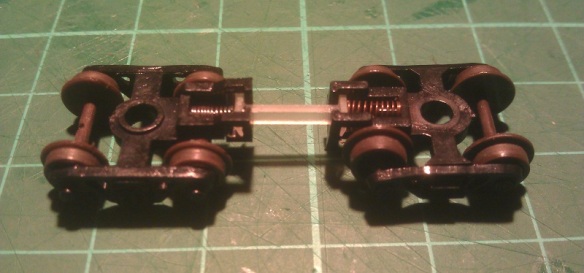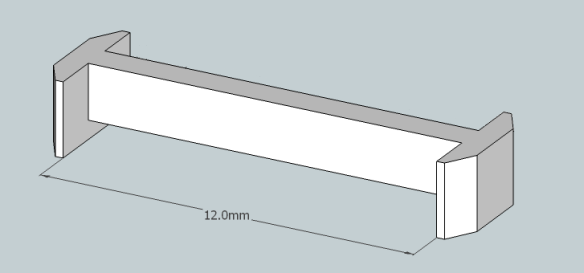This week I have another product update to share with you. Unlike last week’s update, for the Minitrix eccentric rod crankpin, which was driven by improving the part, this time it’s simply about reducing the cost to you.
For many years I’ve offered N scale and N Gauge fixed link couplings or drawbars to use between rolling stock or, as I like to use them, between multiple diesels that stay coupled together. This is really useful if you install a DCC decoder in one locomotive which drives both motors, you can read more about that here. These drawbars are designed to fit into the Rapido style coupling pockets as you can see below.

To start with these couplings were offered in Shapeways FD (Frosted Detail) material but as that was removed from the available materials they automatically became available in FUD (Frosted Ultra Detail) and sadly the cost went up a bit. When Shapeways restructured their material pricing again back in June of 2017 these became rather expensive. However, just as with the Minitrix crank pins from last week I’ve combined the fixed links or drawbars into one piece making them much cheaper to order, as you can see below.

And I’ve also made the primary material BNVP (Black Natural Versatile Plastic) formally known as Black Strong & Flexible. This is one of the cheaper materials; it’s already a good color for a coupling and can be used right out of the box. Below you can see a set I’ve already ordered.

These are available in a variety of lengths and all come in packs of 6:
4mm
5mm
6mm
6.5mm
7mm
8mm
9mm
10mm
11mm
12mm
13mm
And if you’re not sure which lengths you need I do have two sample packs available:
Basic Sample Set – Containing 4mm, 5mm, 6mm, 6.5mm, 7mm, 8mm & 9mm.
Full Sample Set – Containing 4mm, 5mm, 6mm, 6.5mm, 7mm, 8mm, 9mm, 10mm, 11mm, 12mm & 13mm.
The length refers to the distance from the inside of the coupling pocket, for instance the 12mm is measured like this:
 Next week I’ll have some real steam to share with you as I spent a day at ‘The Great Dorset Steam Fair 2018’.
Next week I’ll have some real steam to share with you as I spent a day at ‘The Great Dorset Steam Fair 2018’.


 This did help and made it much easier to reinstall the rivet. But the issue of re-flaring the rivet was still a problem and I was finding it hard to do as I couldn’t get a supply of new rivets. This lead me to start cutting part of the loop away to leave a ‘C’ shape which could be forced over the rivet. As it is a ‘C’ shape it would not fall back off the rivet and the rivet didn’t need to be un-flared in the first place. The original peg, what was left of it, could be cut away and the new one could simply be clipped in.
This did help and made it much easier to reinstall the rivet. But the issue of re-flaring the rivet was still a problem and I was finding it hard to do as I couldn’t get a supply of new rivets. This lead me to start cutting part of the loop away to leave a ‘C’ shape which could be forced over the rivet. As it is a ‘C’ shape it would not fall back off the rivet and the rivet didn’t need to be un-flared in the first place. The original peg, what was left of it, could be cut away and the new one could simply be clipped in. Then in June 2017 when Shapeways restructured their pricing system this model became rather expensive as each individual part had an additional $1 handling charge added to the cost. But the answer is my new Mk4 version of the crank pin which you can see below.
Then in June 2017 when Shapeways restructured their pricing system this model became rather expensive as each individual part had an additional $1 handling charge added to the cost. But the answer is my new Mk4 version of the crank pin which you can see below.











 The gray wire is the bottom motor feed and runs outside the chassis and is soldered onto the bottom motor tab.
The gray wire is the bottom motor feed and runs outside the chassis and is soldered onto the bottom motor tab.


You must be logged in to post a comment.